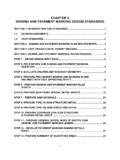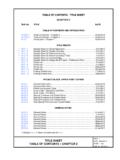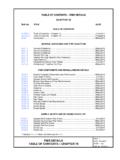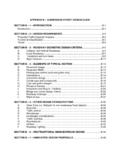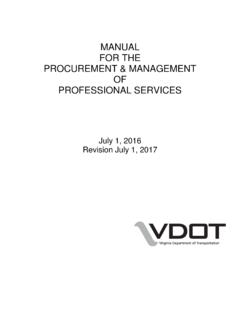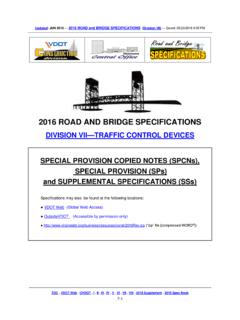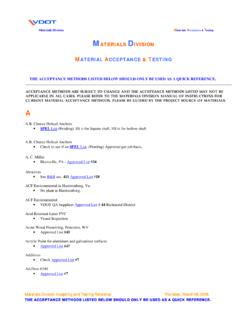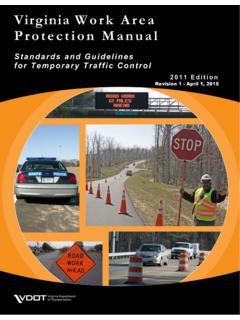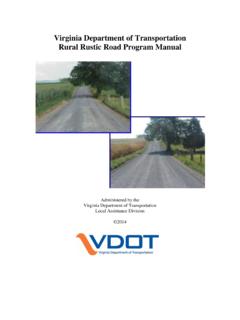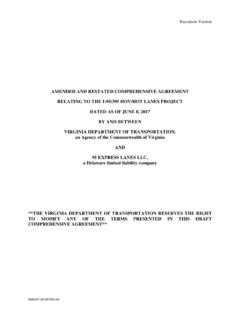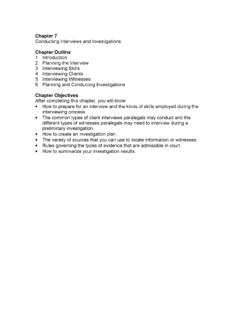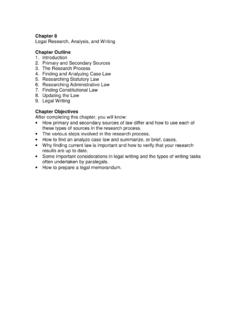Transcription of Chapter 3 - Documentation
1 VDOT Drainage Manual 3-i Chapter 3 - Documentation Chapter 3 - Documentation TABLE OF CONTENTS Chapter 3 - Documentation .. 3-1 Overview .. 3-1 introduction .. 3-1 Definition .. 3-1 Purpose .. 3-1 Types .. 3-2 Scheduling .. 3-3 Responsibility .. 3-4 Procedure .. 3-5 introduction .. 3-5 Practices .. 3-5 Storage .. 3-6 Documentation Procedures .. 3-7 introduction .. 3-7 Computer Files .. 3-7 Schedule .. 3-7 Guidelines .. 3-8 Plan Measurements .. 3-8 Pipe Lengths .. 3-9 Skew Angle of Culverts .. 3-10 Structure Numbers .. 3-10 Protective Coatings .. 3-10 Pipe Descriptions .. 3-11 Typical Culvert 3-13 Concrete Pipe on Radius .. 3-13 Trenchless Applications .. 3-14 Multiple Pipe Installation .. 3-14 Existing Pipe Extension .. 3-14 Box Culvert Descriptions.
2 3-15 Standard (Cast-In-Place) .. 3-15 Precast .. 3-15 Structures .. 3-15 Curb Drop Inlets .. 3-16 Grate Drop Inlets .. 3-17 Manholes .. 3-17 Junction Boxes .. 3-17 Stormwater Management Structures .. 3-18 Existing Structures .. 3-18 Drainage Summaries and Type of Pipe Selection .. 3-20 Post Installation Pipe Inspection .. 3-22 References .. 3-24 VDOT Drainage Manual 3-ii Chapter 3 - Documentation List of Appendices Appendix 3A-1 PFI Milestone Deliverable Appendix 3A-2 PH Milestone Deliverable Appendix 3A-3 FI Milestone Deliverable Appendix 3A-4 PAC Milestone Deliverable Appendix 3A-5 Drainage Summary Appendix 3B-1 Documentation Data Sheet for Hydrologic & Hydraulic Computations Appendix 3B-2 Suggested Outline for VDOT H&H Analysis Report Appendix 3B-3 Field Engineer's Hydraulic Report VDOT Drainage Manual 3-1 of 24 Chapter 3 - Documentation Chapter 3 - Documentation Overview introduction An important part of the design or analysis of any hydraulic facility is the Documentation .
3 Appropriate Documentation of the design of any hydraulic facility is essential because of: The importance of public safety Justification of expenditure of public funds Future reference by engineers (when improvements, changes, or rehabilitations are made to the highway facilities or adjacent property) Information leading to the development of defense in matters of litigation Information is available to public Frequently, it is necessary to refer to plans, specifications, and analysis long after the actual construction has been completed. Documentation permits evaluation of the performance of structures after flood events to determine if the structures performed as anticipated or to establish the cause of unexpected behavior, if such is the case.
4 In the event of a failure, it is essential that contributing factors be identified in order that recurring damage can be avoided. Definition The definition of hydrologic and hydraulic Documentation as used in this Chapter is the compilation and preservation of the design and related details, as well as all pertinent information related to the basis of design and decisions. This should include drainage area and other maps, field survey information, source references, photographs, engineering calculations and analyses, measured and other data, flood history including narratives from newspapers, individuals such as highway maintenance personnel, and local residents who witnessed or had knowledge of an unusual event. Purpose This Chapter describes the Documentation that should be included in the design files and on the construction plans.
5 While the Documentation requirements for existing and proposed drainage facilities are similar, the data retained for existing facilities are often slightly different from that for proposed facilities, and these differences are discussed. This Chapter identifies a system for organizing the Documentation of hydraulic designs and reviews to provide as complete a history of the design process as is practical. Overview Chapter 3- Documentation 3-2 of 24 VDOT Drainage Manual The major purpose of providing good Documentation is to define the design procedure that was used and to show how the final design and decisions were made. There is a myth that avoiding Documentation will prevent or limit litigation losses as it supposedly precludes providing the plaintiff with incriminating evidence.
6 This is seldom if ever the case and Documentation should be viewed as the record of reasonable and prudent design analysis based on the best available technology. Thus, good Documentation can provide the following: Protection for the Department by proving that reasonable and prudent actions, were in fact, taken (such proof should certainly not increase the potential court award, and may decrease it by disproving any claims of negligence by the plaintiff) Identifying the situation at the time of design which might be very important if legal action occurs in the future Documenting that rationally accepted procedures and analysis were used at the time of the design which were commensurate with the perceived site importance and flood hazard (this should further disprove any negligence claims)
7 A continuous site history to facilitate future reconstruction The file data necessary to quickly evaluate any future site problems that might occur during the facilities service life Expediting plan development by clearly providing the reasons and rationale for specific design decisions Types Three basic types of Documentation should be considered: preconstruction, design, and construction or operation. 1. Preconstruction Documentation should include the following if available or within the budgetary constraints of the project. Aerial photographs Topographic mapping with contours Watershed map or plan including - Flow directions - Watershed boundaries - Watershed areas quantified - Natural storage areas - Existing and proposed contours Surveyed data reduced to include - Existing hydraulic facilities - Existing controls - Profiles - roadway, channel, driveways - Cross sections - roadway, channels, faces of structures - Overview VDOT Drainage Manual 3-3 of 24 Chapter 3 - Documentation Flood insurance studies (including any available hydraulic model data), and maps by FEMA Soil Conservation Service soil maps Field trip report(s) which may include.
8 - Video cassette recordings - Audio tape recordings - Still camera photographs - Written analysis of findings with sketches Reports from other agencies (local, State or Federal), VDOT personnel, newspapers, and abutting property owners 2. Design Documentation should include all the information used to justify the design, including: Reports from other agencies Hydrological report Hydraulic report 3. Construction and operation Documentation should include: Plans Revisions As-built plans and subsurface borings Photographs Record of operation: during flooding events, complaints, and resolutions It is very important to prepare and maintain, in a permanent file, any available as-built plans and plan revisions for every drainage structure to document subsurface foundation elements; such as, footing types and elevations, pile types, and (driven) tip elevations, etc.
9 There may be other information which should be included or may become evident as the design or investigation develops. This additional information should be incorporated at the discretion of the designer. Scheduling Documentation should not be considered as occurring at specific times during the design or as the final step in the process, which could be long after the final design is completed. Documentation should be an ongoing process and part of each step in the hydrologic and hydraulic analyses and the design process. This will increase the accuracy of the Documentation , provide data for future steps in the plan development process, and provide consistency and continuity in the design even when different designers are involved at different times of the plan development process.
10 Overview Chapter 3- Documentation 3-4 of 24 VDOT Drainage Manual Responsibility The designer should be responsible for determining what hydrologic analyses, hydraulic design, and related information should be documented during the plan development process. This designer should make a determination that complete Documentation has been achieved during the plan development process which will include the final design. To assist in this determination, refer to Appendix 3B for the following: Project Documentation Checklist (Appendix 3B-1) Suggested outline for a VDOT Hydrologic and Hydraulic Analysis Report (Appendix 3B-2) Field Engineer s Hydraulic Report (Appendix 3B-3) - Procedure VDOT Drainage Manual 3-5 of 24 Chapter 3 - Documentation Procedure introduction The designer should maintain a complete hydrologic and hydraulic design and analysis Documentation file for each waterway encroachment or crossing.
